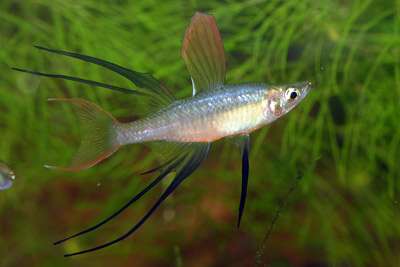Sexiness doesn't always have a downside

(Phys.org) —University of Queensland researchers have found that sexiness doesn't have to be a burden, at least not if you're a male threadfin rainbowfish.
The researchers have tested the evolutionary theory assumption that only the best individuals are able to bear the energetic or survival costs associated with the long, flamboyant fins of male threadfin rainbowfish.
School of Biological Sciences Associate Professor Robbie Wilson said developing and maintaining an outrageously elongated tail, heavy horns, or conspicuously-bright scales could take a lot of energy and increase the risk of being captured by a predator.
"A male who can thrive in spite of his sexy features? Now that's attractive," he said.
Male threadfins, found in streams and lakes across the top end of Australia, develop extensive trailing fin streamers, presumably at great cost to their swimming abilities.
Swimming is an energetically expensive activity, and changes to a fish's hydrodynamic profile – for example, via a greatly elongated fin – should increase the energy needed to swim and decrease overall swimming performance.
Associate Professor Wilson, researcher Andrew Trappett, and colleagues measured the metabolic rates and sprint swimming speeds of male fish with varying natural fin lengths, and then re-measured males after experimentally shortening their fins.
"We found what we expected: that female threadfins preferred males with longer ornaments, but we were surprised to find no evidence that longer fins were hydrodynamically costly to males."
"Males swam just as fast after their fins were shortened as before, and fin size didn't affect metabolic rates during swimming."
Associate Professor Wilson's team has seemingly shown that sexiness doesn't have to be a burden.
"Although a threadfin's ornaments didn't affect its metabolic rate or swimming speeds, it doesn't mean its sexy fins aren't costly," he said.
To ensure that Professor Wilson's study didn't measure the wrong thing, the next research step involves looking at how ornament length relates to a male's ability to survive in more-natural conditions, where escaping predation depends on more than just swimming fast.
The findings of UQ's School of Biological Sciences Professor Robbie Wilson's and his colleagues research are published in the journal Functional Ecology.
More information: www.wilsonperformancelab.com/
Journal information: Functional Ecology
Provided by University of Queensland

















